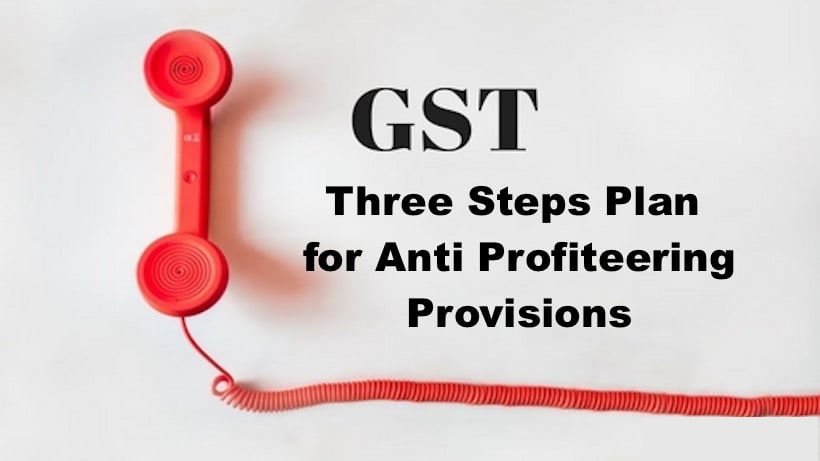Anti Profiteering Provisions: GST is a reality from 1 July 2017. There are still several areas of doubt for taxpayers on the overall law and its implementation, and the ‘Anti Profiteering Provisions’ seems to be at the forefront of things. In this regard, Rule 122 to 137 of CGST Rules deal with Anti-profiteering. However, neither section 171 and nor CGST Rules lay down method to compute the anti-profiteering benefits. Thus, Anti-profiteering guidelines could be prescribed in the near future.
Anti Profiteering Provisions
What the section says?
For ease of reference, section 171 is reproduced below:
171. (1) Any reduction in rate of tax on any supply of goods or services or the benefit of input tax credit shall be passed on to the recipient by way of commensurate reduction in prices.
(2) The Central Government may, on recommendations of the Council, by notification, constitute an Authority, or empower an existing Authority constituted under any law for the time being in force, to examine whether input tax credits availed by any registered person or the reduction in the tax rate have actually resulted in a commensurate reduction in the price of the goods or services or both supplied by him.
(3) The Authority referred to in sub-section (2) shall exercise such powers and discharge such functions as may be prescribed.
What is the Anti-Profiteering Provision?
The Central GST law, as passed by the Parliament, contains an antiprofiteering clause that mandates the manufacturer and others in the supply chain to pass on the benefits arising during the transition phase from current tax regime to GST regime, to the consumers.
Globally, Australia is said to be the first country to introduce an antiprofiteering provision during GST introduction in the year 2000, followed by Malaysia in the year 2015. Though there are no empirical studies to prove its benefits, the Government appears to be inclined to experiment with these provisions in India as well.
The provision in the Central GST Act – Section 171, mandates that benefits arising due to either lower tax rates or more tax credits being available in the GST regime should be passed on to the consumer by way of commensurate reduction in prices. This section also empowers the Government to constitute an authority or entrust an existing authority to ensure compliance of anti-profiteering provisions. Therefore, it is of paramount importance for companies to set up processes to compute the likely benefits and have a plan to ensure smooth passage of the benefits to the consumer.
1. Computing Benefits due to Lower Tax Rates and Increased Credits
Currently, guidelines to compute the benefits have not been prescribed, yet taxpayers can compute the likely benefit at a broader level. The provision categorizes the likely benefits in two baskets:
a. More input tax credits becoming available
At present, Central Sales Tax (CST) is a cost in the supply chain, while in GST regime there will be no CST. This could be construed as a benefit arising due to transition to GST. Today service providers cannot claim credit of VAT paid on goods, and traders cannot claim credit of excise/ countervailing duty and service tax. Going forward, these credits are expected to accrue to a taxpayer. Taxpayer should identify these benefits arising on account of transition to GST at organizational level.
Tax benefits can also be computed at the product level based on a cost sheet.
b. Reduction in tax rates
Once benefits arising from credit are captured, the next step should be to compute benefits from rate reduction, if any. This benefit may be computed at the product level.
Say, for example, one unit of toothpaste of Rs. 10 attracts excise and VAT of Rs 3 today. If GST payable on toothpaste is Rs. 2, then Rs. 1 would be the likely benefit.
2. Looping in Vendors / Supply Chain
While the above steps provide clarity in understanding how much benefit is arising at the manufacturing level, the company will also have to ensure that their vendors pass on the benefits by way of price reduction.
To do this, the company will be required to get cost data from vendors. Once details are shared by vendors, their veracity should be verified by the company or through an independent firm. In case vendors are not willing to share details, some sample cost sheets can be prepared based on industry knowledge. The expected amount of benefits thus arrived at could be shared with vendors for confirmation and used for negotiation.
To ensure that vendors comply with the company’s requests, it is advisable to add an appropriate anti-profiteering clause in the vendor agreement stating that that the vendor agrees to comply with antiprofiteering provisions and to share authentic and verified data to ensure that the benefit is appropriately passed on in accordance with the provisions. Going a step further, the clause can also state that in case appropriate benefit is not passed to the customer, then the vendor will be held accountable to pay any future disputed liability along with interest, fine, penalty, litigation cost etc.
3. Preparing for the Unknown
The anti-profiteering provisions in the GST Act are very brief, leaving enough room for misperceptions and perplexities. While the two steps mentioned above can help the company prepare for business conducted in the future, there are several questions on the business at hand that still remain unanswered. Questions such as how to change MRPs if products are already at the retail store, Is compliance mandatory even if the product is covered under drug pricing control order etc. still need clarifications.
For questions such as these, taxpayers need to be vigilant to announcements from the government on the topic and plan their processes accordingly.
Let’s hope that the anti-profiteering provisions are not perceived as ‘antiindustry’ and the Government issues detailed guidelines to ensure that industry specific challenges are appropriately addressed.
Author: CA Pritam Mahure ([email protected])
Recommended Articles
